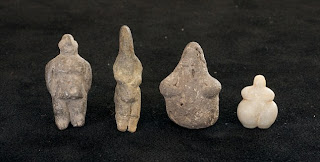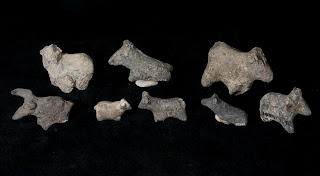Thursday, July 29th, 2010
Prehistoric Playskool?
Yesterday I was doing a little research on a female figurine from Çatal Höyük. This figurine (shown right), dates from the 7th century BC. It was excavated in the 1960s by James Mellaart, who argued that this figurine (and the other female figurines found on the complex) are proof that a matriarchal society and goddess cult existed at Çatal Höyük. However, today archaeologists are questioning Mellaart’s goddess argument. Michael Balter points out that Mellaart developed his goddess theory in the 1960s, just when feminist movements were beginning across the world. I think it’s likely that Mellaart was influenced by his own cultural surroundings (and perhaps a desire to capture the interest of the general public?) when he came to conclusions about a Neolithic goddess cult and matriarchal society.
There are other reasons why scholars doubt Mellaart’s conclusions. One of the main reasons is that there is actually very little evidence of a goddess cult. Along these lines, relatively recent excavations have found close to 2,000 figurines at Çatal Höyük, and most of them are not female figurines. Actually, as reported here, less than 5% of the figurines could be considered female. Most of the figurines are representations of sheep and goats.
So, what was the function of these small figurines? Some scholars think that they could have been used as teaching aides or educational toys! It appears that these figurines were carried around and then discarded (these figurines were discovered in the Stone Age trash). Prof. Lynn Gaskell (Stanford University) is quoted in this article saying, “These are things that were made and used on a daily basis. People carried them around and then discarded them.” Basically, these figurines could have been the prehistoric version of action figures! Here are a couple of figurines discovered at the site:
I think that this is a really interesting and fun theory, although I have some doubts. Just like Mellaart’s theory might have been influenced by the onset of the feminist movement, couldn’t this toy theory also be influenced by our 21st century mindset? Just because children play with action figurines today (and because we throw toys away when they are broken or abandoned), how do we know that Neolithic people acted the same way?



Bah, i was only trying fix those misspellings.
Fun theory indeed, i wouldn't agree though.
If those are just toys, why neolithic people had so much effort on them to carve from stone. And that figurine on the first picture is obviously a goddess; she sits on a throne with two panthers next to her. Athena also has the same exposuring in some statues in Anatolia (throne and panthers/tigers).
There are also lots of penis figurines in Çatalhöyük, that's also why i'm hoping they weren't toys (21. century mindset here, i know).
I think it's an interesting theory — that they could be merely toys — because I like how the theory "normalizes" their society. I think that a lot of people have this idea that ancient societies were very different, very foreign, and very peculiar from modern society. I like that it makes them seem more human rather than abstract (if any of this makes sense). Basically, I like the idea that they were more like us than we tend to realize.
Argh, you're reminding me why I hate archaeology now. 🙂
The toy theory MIGHT be true, but I agree with Hazar–why make toys for kids out of stone? If they were of straw or cloth I might see it, but stone? Meh. Some the American Pueblo tribes make "toys" to teach their kids about the world, but those are made out of cloth, wood, etc.
Furthermore, the majority of figures might not be of women, but how many are figures of men? To me it just seems like the archaeologists looking for excuses to argue the goddess theory. I'm not saying evidence supports a society with a "goddess cult" (why do they always use the term cult, btw?) but it certainly doesn't support anything else more.
Hazar and heidenkind, I think you bring up an interesting point about making things out of stone. I definitely can see your point, although I wonder what was going through the minds of Neolithic parents. As the parent of a toddler, I only want to give my kid toys that are extremely study and will last a long time. Would Neolithic parents have been driven to stone toys if their children had destroyed everything made from softer material? Ha! Or, then again, perhaps Neolithic children were more disciplined and careful than kids who are born today. 🙂
Yeah, e, it is also fun to think about how prehistoric people are more like us than we realize. It makes them seem more approachable, and more human. I really like looking at the cave paintings at Peche Merle, because they show paintings of human hands (see detail here). Seeing the actual hand prints of prehistoric people makes me feel more connected with them. It reminds me that these people were humans too, with hands and bodies and lives, just like people today.
I like your question about how many male figures are at Çatal Höyük, heidenkind. That is a really good question. It would be nice to get statistics. James Mellaart's book "Catal Huyuk: A Neolithic Town in Anatolia" mentioned that the female figurines outnumbered the male figurines (p. 181), but I would be interested to find more current discussion on that topic.
(I also am wondering how phallic figurines (that Hazar mentioned) would have fit into that society. Would phallic figurines be more appropriate for a patriarchal or matriarchal society? I'm inclined to think the former, but I don't know.)
Wow, that hand print is VERY cool. Definitely humanizes them.